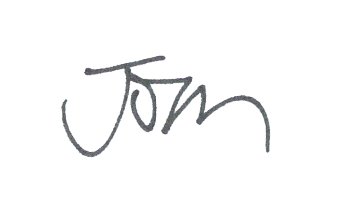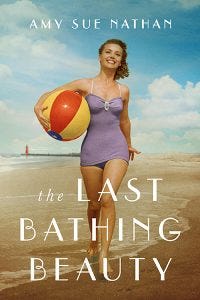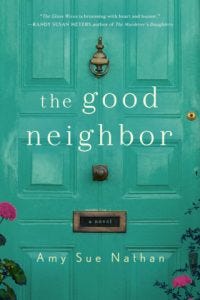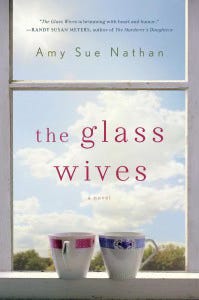I want to write a note about my friend Amy who has recently passed away.
In this age of transparency and putting it all out there, it can feel weirdly self-serving to write about grief. In my writing, I’m interested in acknowledging women who are overshadowed in history. Amy would probably grin at that connection and make a wisecrack (“you think I’m THAT old?!”), but sharing a little about her fits.
For I want to tell stories about people who use compassion and determination to beat the odds.
Author Amy Sue Nathan died last Friday at age 59. Yesterday (Monday, Feb 26) was her birthday. She died ahead of her time. She died saying and writing words that mattered. She died after making a difference to thousands of people she touched in person and through her blogging and teaching and novel-writing. Many, many others knew her deeper and better than me in our brief years of friendship.
All I know is that I’m grateful for that short time we were connected.
It started four years ago.
It’s January and the pandemic’s around the corner, though no one knows it. At the time, I’m scrambling a bit. I’ve pretty much realized I’ll need to trash my first novel and start over. I’m worn out, bummed out, getting a glimmer of how writing fiction is harder for me than I thought. Wishing and worrying that I may not have the writing chops I thought I had.
I had joined an organization with a cool group of women fiction writers (Women Fiction Writers Association) when a mutual friend Zoom-introduces me to Amy.
I’m starstruck.
Amy makes a living as an author. She’s living the dream. Published by Lake Union and St. Martin’s Press, a member of the Tall Poppies elite marketing collective, a writing instructor for Gotham Writers Workshop. She’s one of the original mommy bloggers and founded Women’s Fiction Writers Blog.
When she finds out I’ve started a fledgling historical fiction affinity group, she offers to join. She invites me to come to an early bird 7:00 am “write-in” where a half dozen authors gather via Zoom to sign in and write silently together.
I begin my novel again. There’s a beautiful pull to fellow writers showing up for each other.
Then Amy and I occasionally find ourselves in a smaller author group. I can risk newbie questions without feeling judged. She doesn’t beat around the bush. A straight shooter. For instance, I ask how do I show big chunks of time passing by without making the story drag? Amy regards me calmly. “Copy others,” she says. “Not to plagiarize. Get 3x5 cards and write down the way other authors do it. That’s what I did. After a while, your phrases will come naturally.”
It works.
It’s shortly after this exchange that Amy shares that her balance is off. Living alone, this freaked her (and us) out. She rearranges the furniture, so handholds are quicker to grab.
Each time we meet the conversation ranges from writing craft to agent know-how to book marketing snafus. It’s grist and gossip. What to do, what to avoid. I am soaking up this world, starting to feel like I’ve moved from the top of the bleachers down towards the field. We play around with an Instagram called Sisterhood of the Writing Pants. Amy bursts out our curmudgeonly motto: “Stay off my lawn!”
Her physical balance is not improving. Out in the world, her fourth book comes out, The Last Bathing Beauty, a dual timeline about a former beauty queen with a twisty plot. It’s greeted with great reviews. My neighborhood book club snatches it up.
All through this time Amy is teaching and writing. When making a living as an author, there are no breaks. I see how at the same time you’re marketing one book; you need to be well on your way writing the next.
The Early Bird Zoom group is still going strong though now Amy sleeps in when she can. On the way to a writers’ conference, two author friends and I visit her. She is working on her next novel, Well-behaved Wives, on an iPad. We gorge on Philly cheesesteaks and authortalk.
Physical difficulties increase. She is finally diagnosed with a terrible atypical disease. In fall 2022, our writer posse visits to say hi. Wouldn’t you know it— the same day Well-behaved Wives hits No. 1 in several Amazon categories! Looking back, I marvel at the timing. Amy’s encircled by author friends who get the author triumph. Whoop!
Time passes: communication becomes harder. Her body has its own agenda, but her mind remains clear.
What is she thinking?
More than physical disability.
When artist Henri Matisse’s health deteriorated in his later years, he found himself spending more time in bed or a wheelchair. Cutting paper was a technique he could do even lying down. He called it “drawing with scissors” and created bold artworks later known as his Cut-Outs.
The 2008 film, The Diving Bell and the Butterfly, is the story based on Jean-Dominque Bauby, the French fashion editor who was incapacitated following a massive stroke. In the film, he communicates (and eventually “dictates” a book) through blinking, showing his thought’s clarity and sense of humor behind the physical picture.
Consider Beethoven’s deafness, Ray Charles’ blindness, and Van Gogh’s mental illness. Physical disability does not define their identities nor creativity. The unique masterly demonstration of their creative genius could not be held up by their conditions.
In the same way, Amy’s wit and smarts live in my memories as tangibly as her books sit on my shelves. No disease defines her. She lives on.
Four years later the Early Bird authors still meet. Since Amy set it up, each one of us has either published a book (or two) or has one that will be published soon. The regular morning hour she established—the habitual discipline and creative outlet she entrenched—carries her legacy too.
Her memory is a blessing.
Thanks for reading,










Funny…I was thinking of Amy this morning and the ran across this post. I never met her but loved (love) her anyway. ♥️
Touching and inspiring, Joan, especially to a newbie like me. And I am so sorry for your loss. I wish I could have known her. I will get acquainted through her books...